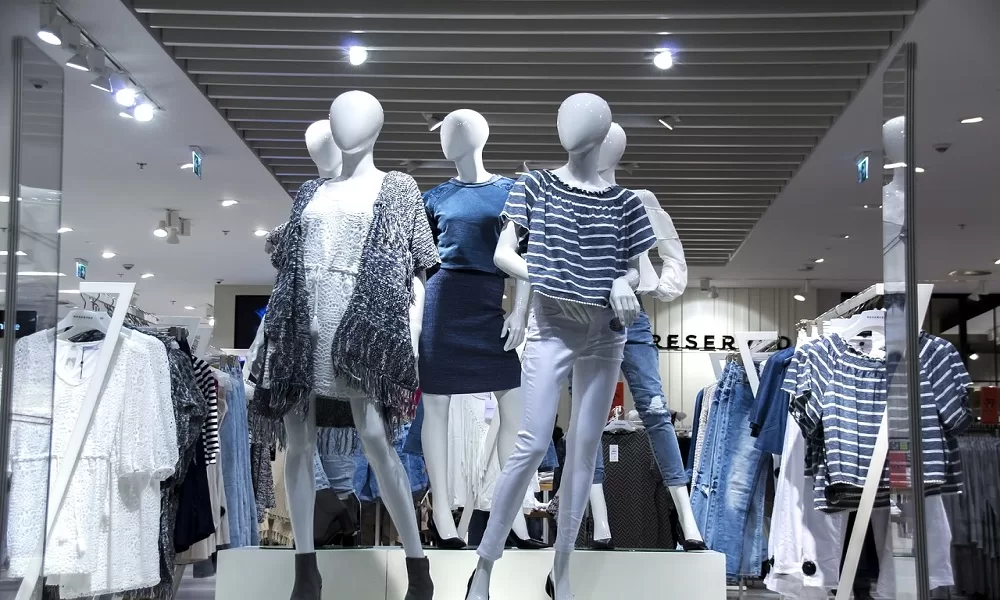What Makes Branded Clothing Ideal for Sensitive Skin?
What Makes Branded Clothing Ideal for Sensitive Skin?
Blog Article
The Importance of Lasting Garments: Just How It Influences the Atmosphere and Your Wardrobe
Lasting clothes is progressively acknowledged for its crucial function in reducing the environmental influence of the fast garment industry. By concentrating on green materials and ethical manufacturing approaches, it addresses pushing eco-friendly worries. This shift not only benefits the earth however likewise influences consumer choices, causing a much more thoughtful approach to wardrobe administration. Recognizing these characteristics increases crucial inquiries concerning fashion's future and individual duty in forming it.
The Environmental Impact of Rapid Style

Benefits of Lasting Products
Sustainable materials use considerable benefits, specifically via green fabric options that reduce environmental harm. These products additionally demonstrate sturdiness and long life, minimizing the need for frequent substitutes. Therefore, they add to an extra lasting apparel industry and advertise accountable customer behavior.
Eco-Friendly Material Selections
While the garment industry has long been linked with fast fads and environmental injury, the increase of eco-friendly fabric choices presents a transformative opportunity. Sustainable products such as organic cotton, hemp, and Tencel have obtained popularity as a result of their lower environmental influence. These materials are usually produced without unsafe pesticides and call for less water, reducing their carbon impact - Branded Clothing. Additionally, lots of environmentally friendly fabrics are biodegradable, adding to a circular economic situation by reducing waste. Picking sustainable materials not just supports ecologically responsible techniques however also advertises much healthier ecosystems. As consumers come to be a lot more mindful of their acquiring power, the need for environment-friendly textiles urges brands to introduce and embrace even more lasting manufacturing methods, inevitably benefiting the world and future generations
Sturdiness and Durability Benefits
Many customers are progressively recognizing the durability and long life benefits of lasting materials in their clothing options. Unlike conventional materials, sustainable materials such as natural cotton, hemp, and recycled polyester are crafted to stand up to damage, leading to garments that last longer. This reduced regularity of substitute not just conserves customers money with time however likewise lessens waste created by quick style. On top of that, lasting garments frequently employs green production methods that improve material stamina, contributing to a reduction in the total carbon impact. By investing in durable clothing, customers can cultivate an extra lasting wardrobe while delighting in premium items that preserve their visual and capability over time. As a result, durability and durability stand as vital benefits of choosing sustainable materials.
Minimizing Waste Through Sustainable Practices
Minimizing waste in the apparel industry can be accomplished with innovative techniques such as upcycling and repurposing products. Additionally, adopting minimal wardrobe methods encourages customers to focus on top quality over amount, eventually reducing clothes consumption. Together, these strategies contribute considerably to a more lasting garments version.
Upcycling and Repurposing Materials
Upcycling and repurposing products have become ingenious methods in the garment industry, changing discarded textiles right into valuable brand-new items. This approach not only lessens waste but also encourages creativity and uniqueness in clothes layout. By taking old garments and products, developers can develop unique pieces that show individual design while lowering the demand for new resources. Additionally, upcycling frequently calls for much less power and water contrasted to conventional manufacturing procedures, significantly reducing the environmental impact of fashion. As consumers end up being a lot more aware of sustainability, the popularity of upcycled apparel remains to rise, promoting a round economy. Inevitably, these techniques add to an extra lasting future, where style focuses on ecological health over rapid production and intake.

Minimalist Closet Techniques
As individuals significantly look for to decrease their environmental influence, adopting minimal closet methods has actually gained grip as an efficient strategy to sustainable style. These strategies emphasize high quality over amount, encouraging customers to curate a smaller sized collection of functional, long lasting garments. By concentrating on classic items that can be blended and matched, people can decrease the regularity of acquisitions and eventually decrease waste.Additionally, minimalism promotes conscious intake, prompting buyers to assess the environmental and honest ramifications of their options. This strategy not just cultivates an extra sustainable lifestyle yet also streamlines everyday decision-making relating to clothing. As individuals welcome minimal concepts, they add to a fashion society that values sustainability and accountable consumerism, ultimately bring about a much more eco-conscious culture.
The Function of Moral Labor in Lasting Fashion
While numerous customers are significantly familiar with the environmental repercussions of their clothing options, the relevance of moral labor practices in lasting fashion can not be neglected. Moral labor encompasses reasonable incomes, safe working conditions, and respect for workers' civil liberties, creating the foundation of responsible style manufacturing. Brand names that focus on ethical labor not only boost neighborhoods however additionally set a criterion for liability in the industry.Moreover, the assimilation of honest techniques promotes openness, allowing customers to make informed selections about their acquisitions. This practice contrasts greatly with rapid fashion's unscrupulous labor versions, which typically prioritize earnings over individuals. By sustaining companies dedicated to moral labor, customers contribute to a system that values human self-respect together with environmental sustainability. Moral labor is not simply an add-on; it is vital to the more comprehensive mission of sustainable style, ensuring that the mission for eco-friendliness does not come at the expense of human legal rights.
The Effect of Sustainable Clothing on Carbon Emissions
Lasting clothing has the possible to substantially decrease carbon emissions connected with the garment industry. Conventional garment manufacturing adds notably to greenhouse gas exhausts, largely as a result of energy-intensive manufacturing procedures and using non-renewable resources. In comparison, sustainable style concentrates on green materials, such as natural cotton or recycled fibers, which often call for much less useful link power to produce.Moreover, sustainable brands tend to embrace much more efficient manufacturing techniques, reducing waste and lowering overall emissions. By prioritizing longevity and ageless layout, lasting clothes encourages customers to purchase much less regularly, more minimizing the carbon impact related to overconsumption.Additionally, several lasting brands are dedicated to openness in their supply chains, allowing customers to make informed choices that straighten with their values. Ultimately, moving towards sustainable apparel can cause a considerable reduction in carbon exhausts, adding to a much healthier earth and a much more sustainable future for the style market.
Sustaining Regional Economic Situations With Sustainable Options
The change towards lasting clothing not just addresses ecological problems yet additionally considerably benefits regional economic climates. By choosing lasting fashion, customers commonly sustain little companies and neighborhood artisans, enhancing area strength. These enterprises generally operate a smaller scale, focusing on craftsmanship and honest methods over mass production.Investing in locally made lasting garments cultivates job production and boosts economic growth within neighborhoods. As consumers become extra knowledgeable about the ecological effect of their purchases, they significantly seek items that mirror their values. This demand motivates regional producers to take on sustainable practices, adding to a round economy.Moreover, supporting regional services lowers transport discharges, lining up with eco-conscious customer actions. The interconnectedness of sustainable garments and local economies highlights the crucial duty that individual choices play in advertising both environmental and financial health and wellness. By fostering these regional connections, neighborhoods can thrive while also functioning towards a more lasting future.
Transforming Your Closet: Tips for a Sustainable Closet
As people look for to reduce their ecological influence, changing a storage room into a sustainable closet comes to be a vital step. One reliable method is to review existing clothes, keeping just things that are worn consistently and that line up with sustainability goals. Prioritizing top quality over quantity is important; purchasing durable items from environmentally friendly brand names can substantially lower waste.Additionally, integrating used things can revive a closet while decreasing ecological damages. Organizing clothing swaps with good friends or giving away unused products can further advertise sustainability.When shopping, individuals ought to seek products that are organic, recycled, or biodegradable, and stay clear of rapid style sellers - Branded Clothing. Finally, practicing mindful intake by attentively considering each acquisition can contribute to a much more sustainable way of life. By see executing these ideas, one can produce a wardrobe that mirrors personal style while supporting ecological stewardship
Frequently Asked Concerns
How Can I Identify Lasting Clothing Brands?
To identify sustainable clothes brands, one ought to look into products made use of, inspect for accreditations like Fair Trade, and check out the brand's transparency about their production processes, labor practices, and environmental impact, ensuring environmentally friendly and honest methods are focused on.
What Are the Prices Related To Lasting Style?
The prices related to lasting fashion can differ substantially. Greater production expenses, honest sourcing, and environmentally friendly products often cause enhanced list prices, which might prevent some customers while interesting ecologically mindful consumers.
Can Sustainable Apparel Be Stylish and trendy?
Lasting clothes can undoubtedly be trendy and trendy. Designers significantly focus on cutting-edge products and ethical manufacturing methods, showing that fashion and sustainability can exist together. Customers currently have diverse alternatives that blend aesthetic appeals with ecological consciousness.
How Does Laundering Clothes Affect Their Sustainability?
Cleaning clothing greatly impacts sustainability by consuming water and power, adding to contamination, and creating microplastic launch. Constant cleaning can weaken materials, reducing their life expectancy and raising the requirement for substitutes, ultimately exacerbating environmental problems.
What Is the Lifespan of Sustainable Clothing Compared to Rapid Style?
The life-span of sustainable garments normally surpasses that of rapid style things, often long-term numerous years because of quality products and craftsmanship. On the other hand, fast style garments might break down promptly, requiring even more constant replacements. Lasting clothes is progressively identified for its important duty in minimizing the environmental visite site effect of the quick fashion industry. While lots of consumers are progressively conscious of the ecological effects of their garments selections, the significance of honest labor practices in sustainable fashion can not be forgotten. Branded Clothing. Lasting garments has the potential to substantially lower carbon emissions associated with the style market. In contrast, sustainable fashion concentrates on environment-friendly products, such as organic cotton or recycled fibers, which usually call for much less energy to produce.Moreover, sustainable brand names tend to embrace extra efficient production techniques, reducing waste and lowering general exhausts. By prioritizing sturdiness and timeless style, sustainable apparel encourages customers to buy much less often, additional decreasing the carbon impact connected with overconsumption.Additionally, numerous sustainable brand names are devoted to transparency in their supply chains, enabling consumers to make educated choices that line up with their values
Report this page